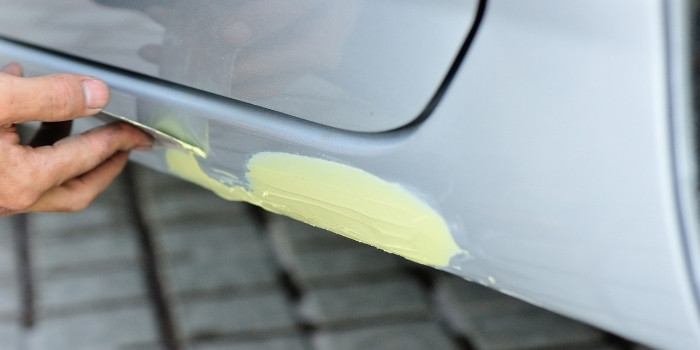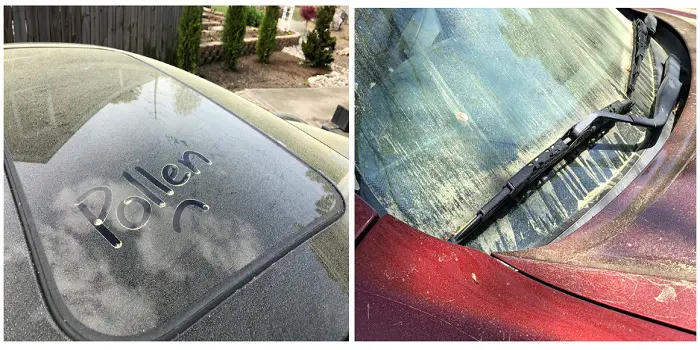
For a long time, body filler has been the preferred method of repairing small dents and damaged areas on cars.
While it used to be available only in a paste form, most modern versions are now sold as an aerosol spray. Once dry, this is a nice smooth surface that can easily be painted over with primer and final paint.
Read on to find out more about how you can use body filler on your car.
Table of Contents
What is a Body Filler?
Body filler is a type of flexible putty that is used to fill body dents and gaps on old worn-out or damaged cars.
When sanded, it becomes hard and relatively smooth. It is available in both paste and sprays forms.
While the paste version was previously the most common way to apply body filler, most modern versions are now sold as an aerosol spray.
Body filler is a lightweight material that is available in several different formulations.
The most common types are made from synthetic plastics, but there are also some materials based on natural resins and waxes.
Uses
a. Fixing Small Dents
Small dents can be fixed with body filler without having to repaint the affected area.
It is a quick and easy method that produces good results, especially if you have had paintwork done by professionals.
If your car has been painted recently, then it might not be a good idea to do the repairs yourself.
The paintwork is matched to the surrounding area, so it has a different sheen and texture.
b. Filling Gaps and Cracks
Car bodies tend to expand and contract slightly depending on the weather.
This means that there will often be small gaps and cracks in the bodywork, especially around doors and other areas where parts of the car meet up.
These can sometimes be difficult to notice until you walk around the car, so it is best to keep an eye out for them.
If you find one, then it is best to fill it with body filler so that the gap will not expand any further.
c. Filling Small Holes
Small holes in your car’s bodywork can be difficult to spot, especially if they are covered by paint or other materials on the surface of the car.
It is best to find these holes while the car is still on the ground since they are bound to be more difficult to access once it is in the air.
If you do find a hole while working, then use body filler to make sure that the damage does not get any worse.
Different types
1- Polyester body filler
Polyester body filler is one of the most common types available today.
The main advantage of this type of material is that it works well with both high and low-temperature painting processes.
It also shrinks very little when it dries, so you can use more than one layer without problems.
2- Polyurethane body filler
Polyurethane body filler is a good choice if you are looking for a strong and durable solution for your car.
It has a nice smooth finish, so it can be used on all surfaces without any problems. If you have recently painted the affected area, then make sure to test this type of body filler first.
3- Epoxy resin body fillers
Epoxy resin body fillers combine the strength of polyurethane fillers with a smooth finish that is similar to polyester fillers.
This type of material has good gap-filling abilities, so it is often used for this purpose.
Epoxy body fillers are very durable, so they can be used to repair areas where the car will see a lot of wear and tear.
4- Gel-coat body filler
Gel-coat filler is another type of polyester resin that is used to fill small holes and cracks in the bodywork.
The main difference is that it has a gel texture, so it fills gaps better than other types of fillers.
This requires fewer layers, which improves the final results. Gel-coat is also very easy to sand down, so this is one of the best options for beginners.
Stopper vs. Filler: What’s the Difference?
Unlike many beliefs, body filler and stopper are not the same but different.
Filler is stronger and is generally used for a larger area.
For filling up a large gap in a panel, a bridging filler will do the best task as it comes with fiberglass particles for extra strength.
Stopper, on the other hand, is a lot finer substance and is recommended to be used for fixing minor imperfections such as tiny pinholes.

How to Use Body Filler for Your Car Repair?
If you are using a body filler like Bondo, Evercoat, Tiger hair fiberglass filler, or any other for car repairs, make sure you follow the right steps to get the desired results.
Regardless of what brand you use, here are a few general steps you will need to follow…
Step 1- Prepare the Surface
Fix any rust or corrosion before you start working with body filler.
This is important because it can make for a much better repair job overall, especially if you are trying to patch up the metal surrounding the small holes or cracks.
You can use a wire brush, steel wool, or sandpaper to rub off rust, but make sure you are very careful when doing so.
Then use body repair putty to fill in larger holes in your car’s bodywork before using filler.
Body repair putty works similarly to regular filler except that it is softer and more malleable.
This makes it fit into gaps better than regular filler, which prevents any cracks or weak spots from forming as the material hardens.
If you do not want to use body repair putty, then make sure you clean out and smooth over holes and cracks before applying filler.
Step 2- Spread the Filler
Use your putty knife to fill small cracks with body filler.
Make sure the blade of the knife is flat so that it will lie flush against the surface of the car when you are spreading the filler around the area to be repaired.
Spread body filler over large areas using a wide palette knife or spatula.
Use your spatula to spread the body filler from one corner of the area to the other, but make sure you do not overdo it.
If you can see any ridges or lines when you are finished, then use another layer of filler on top of the first.
Use a plastic putty knife to smooth out all of your patches and ridges.
Tap the knife against the patch to even out any bumps, making sure it is flush with the surface of the car.
Step 3- Seal the Body Filler
Use regular water if you need to seal your filler. If this will not work, then use a suitable coating to protect your paint job from moisture and other elements.
Let the filler dry for between 30 minutes to one hour before applying another layer of material.
If you are using epoxy resin filler, wait at least 24 hours before applying more layers.
Use fine-grit sandpaper to smooth over the surface of your body filler once it has dried completely. You can use 120- or 220-grit sandpaper for this.
Polish the filler with rubbing compound if you want to enhance any of your paint jobs after filling small areas with bodywork filler.
Rubbing compound creates a high gloss finish on top of the filler, making it easier to match up with the surrounding area.
Use a primer before laying down any color on top of your body filler.
This will make it easier to cover up small holes or cracks that might be exposed when you are working with the paint job.
Tips and Cautions
Make sure you wear a mask when working with body filler materials.
The chemicals in these types of material can be very dangerous if inhaled or allowed to come into contact with your skin.
Avoid prolonged exposure to the sun, as this may cause the filler to dry out and become useless.
You should also try to avoid strong UV rays while it is drying.
Sand before you paint if you want to achieve a smooth finish on top of the filler material.
This will keep your car looking its best regardless of what type of damage or accident it has sustained in the past.
Follow these simple steps to ensure you use body filler on your car repairs in the best way possible.
Make sure you read and follow all instructions carefully when using any type of filler or other similar materials for your car.
How to Choose the Best Body Filler for Your Car?
When choosing a body filler, it is important to consider the type of metal you will be working with.
Steel and aluminum for example will require different types of fillers than the materials like plastic, and fiberglass.
Some fillers are designed for use with specific primers, so be sure to read the labels carefully before making your purchase.
In general, however, any good-quality body filler will do the trick.
If you are working with a large area, it is best to choose a product that can be spread thin. This will save you time and money in the long run.
For smaller jobs, a product that dries quickly may be your best bet. This way, you won’t have to wait around for the filler to dry before you can sand it smooth.
Once you’ve chosen the right body filler for your project, be sure to follow the instructions on the package carefully. This will ensure that the filler adheres properly and dries correctly.
What’s the Difference Between a Body Filler and Bondo?
Body filler is a type of putty used to fill in dents and other imperfections in auto body panels.
Bondo is a brand name for body filler, but there are many other brands available. Body filler is typically made of resin and a hardener, and it can be sanded smooth once it dries.
Bondo is a two-part epoxy putty that is used to fill in holes, dents, and other imperfections in auto body panels. It can be sanded smooth once it dries.
Both body filler and Bondo are available at auto parts stores.
When used as a filler, both Bondo and an ordinary one may endure for years. Some vehicle owners have had their cars’ bodies protected using Bondo for more than eight years.
However, there are several elements that influence how long Bondo lasts on your car’s body.

Based in Orem (Utah) John Paterson graduated from Utah Valley University and has begun writing in 2009. He has a large wealth of experience in writing articles related to cars, automotive repair, wheels, cleaning/maintenance, and much more. He has also written instructional articles in a similar niche for a few online publications as well. Currently, he works as a mechanic in his personal garage shop where he loves serving his countrymen from his heart.




